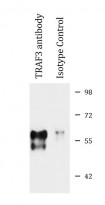ARG40750
anti-TRAF3 antibody
anti-TRAF3 antibody for ICC/IF,IHC-Formalin-fixed paraffin-embedded sections,Western blot and Human,Mouse,Rat
Overview
| Product Description | Rabbit Polyclonal antibody recognizes TRAF3 |
|---|---|
| Tested Reactivity | Hu, Ms, Rat |
| Tested Application | ICC/IF, IHC-P, WB |
| Host | Rabbit |
| Clonality | Polyclonal |
| Isotype | IgG |
| Target Name | TRAF3 |
| Antigen Species | Human |
| Immunogen | Synthetic peptide of Human TRAF3. |
| Conjugation | Un-conjugated |
| Alternate Names | LMP1-associated protein 1; EC 6.3.2.-; CD40 receptor-associated factor 1; LAP1; CAP-1; CD40-binding protein; CAP1; CD40BP; IIAE5; CRAF1; CD40bp; TNF receptor-associated factor 3 |
Application Instructions
| Application Suggestion |
|
||||||||
|---|---|---|---|---|---|---|---|---|---|
| Application Note | * The dilutions indicate recommended starting dilutions and the optimal dilutions or concentrations should be determined by the scientist. |
Properties
| Form | Liquid |
|---|---|
| Purification | Affinity purified. |
| Buffer | PBS (pH 7.3), 0.02% Sodium azide and 50% Glycerol. |
| Preservative | 0.02% Sodium azide |
| Stabilizer | 50% Glycerol |
| Storage Instruction | For continuous use, store undiluted antibody at 2-8°C for up to a week. For long-term storage, aliquot and store at -20°C. Storage in frost free freezers is not recommended. Avoid repeated freeze/thaw cycles. Suggest spin the vial prior to opening. The antibody solution should be gently mixed before use. |
| Note | For laboratory research only, not for drug, diagnostic or other use. |
Bioinformation
| Database Links | |
|---|---|
| Gene Symbol | TRAF3 |
| Gene Full Name | TNF receptor-associated factor 3 |
| Background | The protein encoded by this gene is a member of the TNF receptor associated factor (TRAF) protein family. TRAF proteins associate with, and mediate the signal transduction from, members of the TNF receptor (TNFR) superfamily. This protein participates in the signal transduction of CD40, a TNFR family member important for the activation of the immune response. This protein is found to be a critical component of the lymphotoxin-beta receptor (LTbetaR) signaling complex, which induces NF-kappaB activation and cell death initiated by LTbeta ligation. Epstein-Barr virus encoded latent infection membrane protein-1 (LMP1) can interact with this and several other members of the TRAF family, which may be essential for the oncogenic effects of LMP1. Several alternatively spliced transcript variants encoding three distinct isoforms have been reported. [provided by RefSeq, Dec 2010] |
| Function | Regulates pathways leading to the activation of NF-kappa-B and MAP kinases, and plays a central role in the regulation of B-cell survival. Part of signaling pathways leading to the production of cytokines and interferon. Required for normal antibody isotype switching from IgM to IgG. Plays a role T-cell dependent immune responses. Plays a role in the regulation of antiviral responses. Is an essential constituent of several E3 ubiquitin-protein ligase complexes. May have E3 ubiquitin-protein ligase activity and promote 'Lys-63'-linked ubiquitination of target proteins. Inhibits activation of NF-kappa-B in response to LTBR stimulation. Inhibits TRAF2-mediated activation of NF-kappa-B. Down-regulates proteolytic processing of NFKB2, and thereby inhibits non-canonical activation of NF-kappa-B. Promotes ubiquitination and proteasomal degradation of MAP3K14. [UniProt] |
| Cellular Localization | Cytoplasm. Endosome. Mitochondrion. Note=Undergoes endocytosis together with TLR4 upon LPS signaling (By similarity). Associated with mitochondria in response to virus. [UniProt] |
| Calculated MW | 64 kDa |
| PTM | Undergoes 'Lys-48'-linked polyubiquitination, leading to its proteasomal degradation in response to signaling by TNFSF13B, TLR4 or through CD40. 'Lys-48'-linked polyubiquitinated form is deubiquitinated by OTUD7B, preventing TRAF3 proteolysis and over-activation of non-canonical NF-kappa-B. Undergoes 'Lys-63'-linked ubiquitination during early stages of virus infection, and 'Lys-48'-linked ubiquitination during later stages. Undergoes both 'Lys-48'-linked and 'Lys-63'-linked ubiquitination in response to TLR3 and TLR4 signaling. Deubiquitinated by OTUB1, OTUB2 and OTUD5. [UniProt] |
Images (2) Click the Picture to Zoom In







